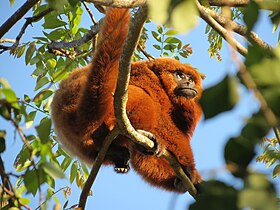Alouatta guariba clamitans
| Alouatta guariba clamitans[1] | |||||||||||||||||||||||||
|---|---|---|---|---|---|---|---|---|---|---|---|---|---|---|---|---|---|---|---|---|---|---|---|---|---|

Fêmea
| |||||||||||||||||||||||||
| Estado de conservação | |||||||||||||||||||||||||
 Vulnerável (IUCN 3.1) [2] | |||||||||||||||||||||||||
| Classificação científica | |||||||||||||||||||||||||
| |||||||||||||||||||||||||
| Nome trinomial | |||||||||||||||||||||||||
| Alouatta guariba clamitans Cabrera, 1940 | |||||||||||||||||||||||||
| Sinónimos | |||||||||||||||||||||||||
| |||||||||||||||||||||||||
Alouatta guariba clamitans é a subespécie do bugio-ruivo encontrada na região sudeste do Brasil até a província de Misiones. Foi considerado por Gregorin (2006) como uma espécie propriamente dita, Alouatta clamitans. Se diferencia da subespécie ao norte do rio Doce por possuir acentuado dimorfismo sexual na pelagem, com os machos sendo ruivos avermelhados, e as fêmeas com de cor mais escura.[3]
Este primata já foi considerado principal hospedeiro de protozoários que transmitem a malária, em especial os Plasmodium das espécies P. brasilianum e P. simium. No entanto, mesmo com a diminuição drástica da população de bugios entre 2016 e 2018, as ocorrências de malária se mantiveram estáveis, indicando que estes animais não seriam os principais reservatórios desta doença.[4]
Referências
- ↑ Groves, C.P. (2005). Wilson, D. E.; Reeder, D. M, eds. Mammal Species of the World 3.ª ed. Baltimore: Johns Hopkins University Press. 149 páginas. ISBN 978-0-8018-8221-0. OCLC 62265494
- ↑ Mendes, S. L., Rylands, A. B., Kierulff, M. C. M.& =de Oliveira, M. M. (2020). Alouatta%20clamitans 'Alouatta clamitans' (em inglês). IUCN 2021. Lista Vermelha de Espécies Ameaçadas da IUCN. 2021. Página visitada em 3 de março 2021..
- ↑ GREGORIN, R. (2006). «Taxonomia e variação geográfica das espécies do gênero Alouatta Lacépède (Primates, Atelidae) no Brasil» (PDF). Revista Brasileira de Zoologia. 23 (1): 64-144
- ↑ Multini, Laura Cristina; de Souza, Ana Letícia da Silva; Marrelli, Mauro Toledo; Wilke, André Barretto Bruno (22 de outubro de 2020). «The influence of anthropogenic habitat fragmentation on the genetic structure and diversity of the malaria vector Anopheles cruzii (Diptera: Culicidae)». Scientific Reports (em inglês) (1). 18018 páginas. ISSN 2045-2322. doi:10.1038/s41598-020-74152-3. Consultado em 28 de agosto de 2023
Text is available under the CC BY-SA 4.0 license; additional terms may apply.
Images, videos and audio are available under their respective licenses.

